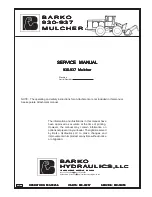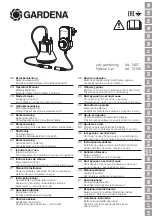
Performance Check— Type 5 0 3
—
I
J
C
L
J
_
C"
L
J
1
i
L
J
l l l l
" I 1
L
J
J
I
L
J
J
L
L
J
L
L
J
i
—t—
1
1
1 '
1
1
_ L _
1
1
1
_ i _
1
1
1
- i l, ,
1
1
__l__
1
1
1
—|---
1
1
1
- 1
1
1
1
—i
---
i
(A ) C 306 misadjusted
(B) C 306 correctly adjusted
Fig. 5-4. Typical displa y, H orizontal A m p lifie r attenua tor compensation check; 1 kHz square-wave inpu t; SWEEP TIM E /C M switch setting, 2 mSEC.
VERTICAL
SENSITIVITY
1 VOLTS/CM
VARIABLE
CALIBRATED
+ INPUT
DC
-IN P U T
GND
HORIZONTAL
SENSITIVITY
.2 VOLTS/CM
VARIABLE
CALIBRATED
+INPUT
DC
-IN P U T
GND
Test Oscilloscope (Type 503)
Sweep Time/cm
2 mSEC
Trigger Source
Ext.
Trigger Level
Adjust for stable display
Horizontal Display
Sweep Normal ( X I )
c. Remove the right side panel from the test oscilloscope
d. Connect a 10X probe to the VERTICAL +INPUT con
nector, and
connect the
probe
tip
to
pin
8
of
V I
60 in the
test oscilloscope (i.e., a test point to obtain a sawtooth
waveform).
e. Connect a 1-kHz square-wave signal from the square-
wave generator through a 50-ohm termination (or 10X atten
uator), a 50-ohm cable, a UHF T connector, and a 47 pF
Input Time - constant Standardizer to the HORIZONTAL
-(-INPUT connector, in the order given.
f. Connect another 50-ohm cable from the UHF T con
nector to the test oscilloscope Ext Trig. In connector.
g. Adjust the test oscilloscope Trigger Level control to
obtain a stable display on the Type 503. The display should
be similar to Fig. 5-4.
h. Adjust the generator output for a 3-cm spacing hori
zontally, and center the display with the HORIZONTAL
POSITION control.
i. Check— Square waveform showing no more than 2%
overshoot, rounding, or tilt.
j. Change the test oscilloscope Sweep Time/cm to .1
millisecond.
k. Check— Square front corner on waveform, showing
no more than 2% rounding or overshoot. See Fig. 5-5 for
typical displays.
l
. Check the square wave response in all remaining
HORIZONTAL SENSITIVITY switch
positions, alternately
switching between the 2 millisecond and 0.1 millisecond
Sweep Time/cm switch positions in the test oscilloscope.
NOTE
A ll a tte n u a to r com pensation checks are made w ith
a d isp la y a m p litu d e o f 3 cm.
Insert or remove
a tte n u a tio n a n d /o r adjust the signal g e nerator
o u tp u t to m aintain this am plitude.
m. Change the HORIZONTAL +IN P U T switch to GND,
the HORIZONTAL — INPUT switch to DC, and move the
Time-constant Standardizer to the HORIZONTAL — INPUT
connector.
n. Repeat steps (g) through (I).
2Q. Check Amplifier Phasing— 1 mY/CM to .2
VOLTS/CM
o. R e q u ire m in W h a n shift not more than 1° to 450 k ill.
b. Set the Type 503 controls as follows:
5 -7
Summary of Contents for 503
Page 5: ...Fig 1 1 Type 503 Oscilloscope Type 503 ...
Page 10: ...O perating Instructions Type 503 2 3 Fig 2 2 Type 503 Oscilloscope front panel ...
Page 23: ...NOTES ...
Page 33: ...NOTES ...
Page 49: ...Type 503 colibrotion__ 6 2 ...
Page 78: ...NOTES ...
Page 111: ...G Ab A B L O C K D I A G R A M ...
Page 112: ...T R K a G iE B IN P U T A M P L IF IE R T V p E 5 0 3 O SCILLO SCO PE D ...
Page 115: ... D Z 2 I j O H OA uit zul Z Q 3 O 0 7 7 ...
Page 116: ...c L O a l LLl A uJ u e x a uJ LLl t i ...
Page 118: ...0 S 2 J 7 ...
Page 119: ... J 0 o lii I in I I I 2 z 3i i pfSg D T IM IN G i S W IT C H ...
Page 121: ...n I u J a d i ...
Page 132: ...FIG 1 FRONT ...
Page 133: ...FIG 1 FRONT TYPE 503 OSCILLOSCOPE ...
Page 134: ...FIG 2 SWITCHES ...
Page 135: ...FIG 2 SWITCHES TYPE 503 OSCILLOSCOPE ...
Page 136: ...FIG 3 CRT SHIELD 2 5 A I ...
Page 137: ...FIG 3 CRT SHIELD f TYPE 503 OSCILLOSCOPE ...
Page 138: ...FIG 4 CHASSIS REAI ...
Page 139: ...TYPE 503 OSCILLOSCOPE ...
Page 140: ...FIG 5 CABINET 7 ...
Page 141: ...TYPE 503 OSCILLOSCOPE ...
















































